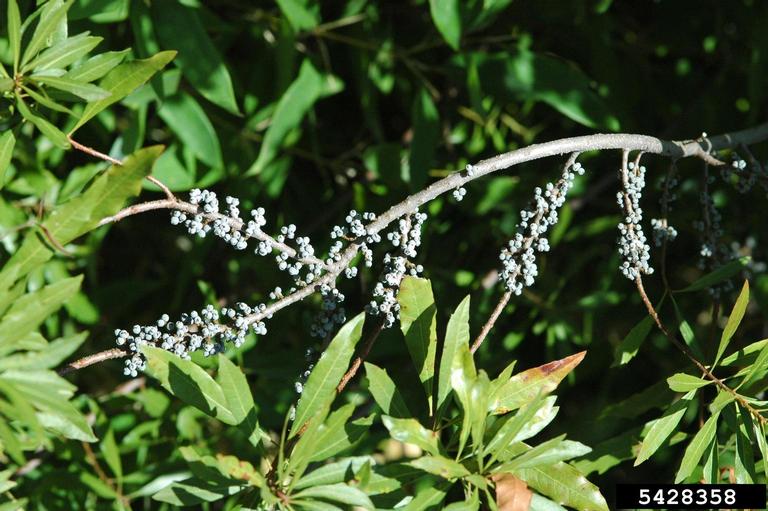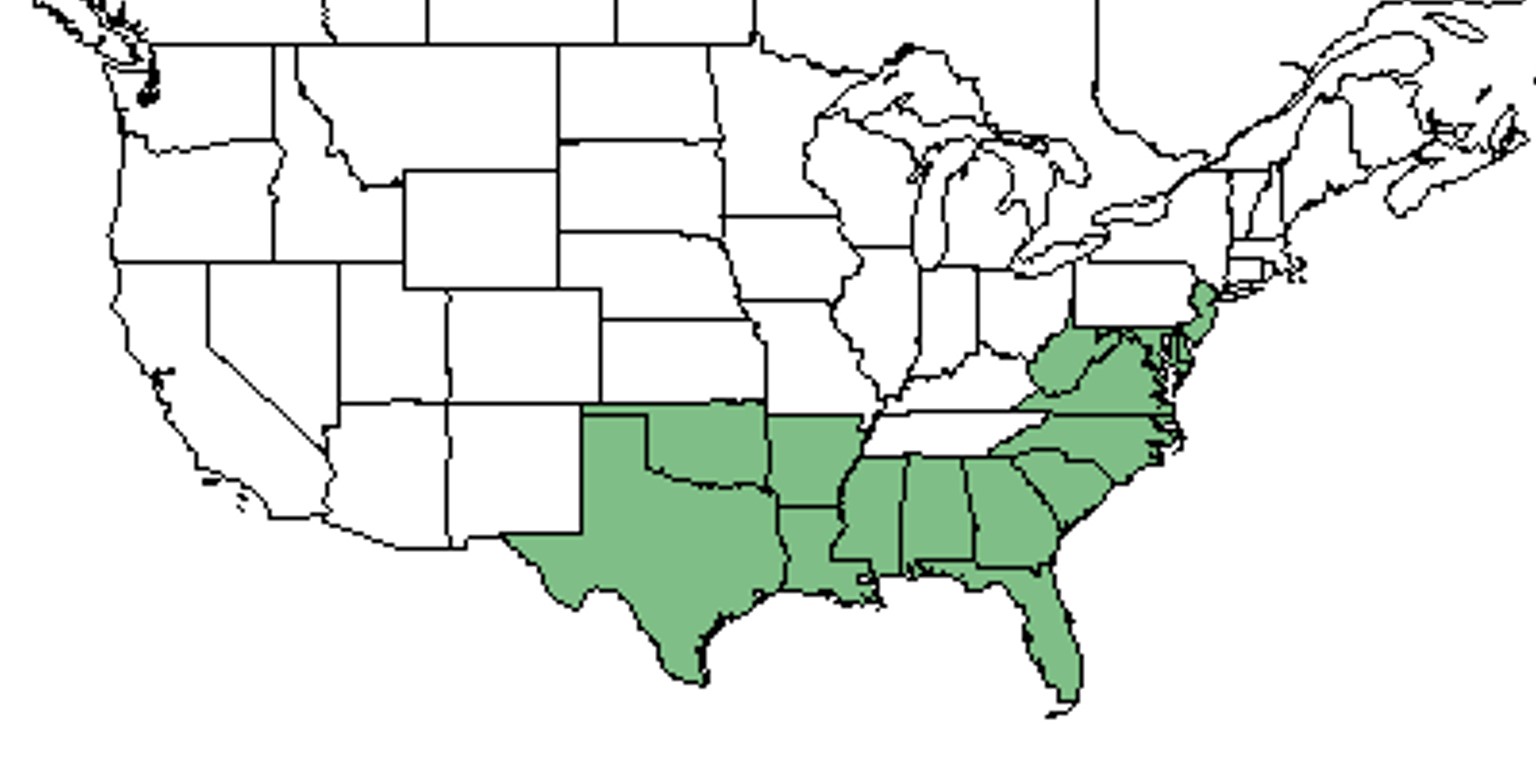Difference between revisions of "Morella cerifera"
HaleighJoM (talk | contribs) (→Ecology) |
HaleighJoM (talk | contribs) |
||
| Line 49: | Line 49: | ||
Populations of ''Morella cerifera'' have been known to persist through repeated annual burns.<ref>Robertson, K.M. Unpublished data collected from Pebble Hill Fire Plots, Pebble Hill Plantation, Thomasville, Georgia.</ref><ref>Glitzenstein, J. S., D. R. Streng, R. E. Masters, K. M. Robertson and S. M. Hermann 2012. Fire-frequency effects on vegetation in north Florida pinelands: Another look at the long-term Stoddard Fire Research Plots at Tall Timbers Research Station. Forest Ecology and Management 264: 197-209.</ref><ref>Platt, W.J., R. Carter, G. Nelson, W. Baker, S. Hermann, J. Kane, L. Anderson, M. Smith, K. Robertson. 2021. Unpublished species list of Wade Tract old-growth longleaf pine savanna, Thomasville, Georgia.</ref> | Populations of ''Morella cerifera'' have been known to persist through repeated annual burns.<ref>Robertson, K.M. Unpublished data collected from Pebble Hill Fire Plots, Pebble Hill Plantation, Thomasville, Georgia.</ref><ref>Glitzenstein, J. S., D. R. Streng, R. E. Masters, K. M. Robertson and S. M. Hermann 2012. Fire-frequency effects on vegetation in north Florida pinelands: Another look at the long-term Stoddard Fire Research Plots at Tall Timbers Research Station. Forest Ecology and Management 264: 197-209.</ref><ref>Platt, W.J., R. Carter, G. Nelson, W. Baker, S. Hermann, J. Kane, L. Anderson, M. Smith, K. Robertson. 2021. Unpublished species list of Wade Tract old-growth longleaf pine savanna, Thomasville, Georgia.</ref> | ||
<!--===Pollination===--> | <!--===Pollination===--> | ||
| − | + | ===Herbivory and toxicology=== <--Common herbivores, granivory, insect hosting, poisonous chemicals, allelopathy, etc.--> | |
| − | ===Herbivory and toxicology===<--Common herbivores, granivory, insect hosting, poisonous chemicals, allelopathy, etc.--> | ||
''Morella cerifera'' has been observed to host plant bugs such as ''Psallus variabilis'' (family Miridae), and leafhoppers from the Cicadellidae family such as ''Empoasca deckeri'' and '' Empoasca fabae''.<ref>Discoverlife.org [https://www.discoverlife.org/20/q?search=Bidens+albaDiscoverlife.org|Discoverlife.org]</ref> | ''Morella cerifera'' has been observed to host plant bugs such as ''Psallus variabilis'' (family Miridae), and leafhoppers from the Cicadellidae family such as ''Empoasca deckeri'' and '' Empoasca fabae''.<ref>Discoverlife.org [https://www.discoverlife.org/20/q?search=Bidens+albaDiscoverlife.org|Discoverlife.org]</ref> | ||
<!--===Diseases and parasites===--> | <!--===Diseases and parasites===--> | ||
Revision as of 19:43, 14 July 2022
| Morella cerfiera | |
|---|---|

| |
| Photo by Karan A. Rawlins, University of Georgia, Bugwood.org | |
| Scientific classification | |
| Kingdom: | Plantae |
| Division: | Tracheophyta- Vascular plants |
| Class: | Magnoliopsida – Dicotyledons |
| Order: | Fagales |
| Family: | Myricaceae |
| Genus: | Morella |
| Species: | M. cerfiera |
| Binomial name | |
| Morella cerfiera (L.) Small | |

| |
| Natural range of Morella cerfiera from USDA NRCS Plants Database. | |
Common names: Common waxmyrtle; Southern bayberry
Contents
Taxonomic notes
Synonyms: Myrica cerifera L.; Myrica cerifera Linnaeus var. cerifera; Cerothamnus ceriferus (Linnaeus) Small.[1]
Varieties: none.[1]
Description
"Dioecious or monoecious shrubs or small trees, with brown to brownish-black, pubescent to glabrate twigs. Leaves deciduous or semi-evergreen, coriaceous, petiolate, exstipulate. Staminate catkins ovoid-cylindric, 0.6-2 cm long, 4-6 mm in diam.; bracteate and bracteolate; stamens 2-1, mostly 2-5. Pistillate catkins ovoid or cylindric, 5-10 mm long, deciduous-bracteate. Fruits drupaceous, white, globose, verrucose, 2.5-7 mm in diam. A taxonomically difficult group with intergrading species."[2]
"Shrub or small tree, 0.3-7 m tall. Leaves oblanceolate or elliptic, to 8 cm long and 2cm wide, heavily resinous on both surfaces, usually pubescent beneath, acute or obtuse, serrate or entire, base cuneate to attenuate, petioles to 1 cm long. Fruits 2.5-3.5 mm in diam."[2]
Distribution
Is found within the Coastal Plain and as far north as New Jersey.[3]
Ecology
Habitat
The species is naturally found in interdune swales, pocosins, brackish marshes, and other wet to moist habitats.[3] Is widely planted as an ornamental or as a landscaping shrub.[3]
M. cerifera has been found in sand barrens, mesic pine hardwood forests, turpentine glades, dry sandstone glades, pond edges, pineland bogs, pine flatwoods, maritime forests, and swamps.[4][5][6][7] It is also found in disturbed areas including highway roadsides, disturbed wetland edges, and disturbed post oak savannah.[5][6][8]
M. cerifera has shown regrowth in response to agricultural-based soil disturbance in South Carolina Coastal Plain communities, making it an indicator species for post-agricultural woodlands.[9] M. cerifera reduced its crown cover and biomass in response to heavy silviculture in north Florida.[10] It decreased its cover in response to clearcutting and chopping in north Florida flatwoods.[11] It also decreased its frequency in response to roller chopping in east Texas pinewoods.[12] This species has shown resistance to regrowth in reestablished native habitats that were disturbed by these practices.[10][11][12] M. cerifera had mixed responses to clearcutting and roller chopping in north Florida and to KG blade disturbance in east Texas.[13][12] Its foliar cover is sometimes dependent on time since disturbance in north Florida flatwoods. In Texas pinewoods, the species typically decreased in frequency or was unaffected by KG blade disturbance.[13][12]
Morella cerifera is frequent and abundant in the Calcareous Savannas community type as described in Carr et al. (2010).[14]
Phenology
This species flowers in April and fruits from August to October.[3]
Fire ecology
Populations of Morella cerifera have been known to persist through repeated annual burns.[15][16][17] ===Herbivory and toxicology=== <--Common herbivores, granivory, insect hosting, poisonous chemicals, allelopathy, etc.--> Morella cerifera has been observed to host plant bugs such as Psallus variabilis (family Miridae), and leafhoppers from the Cicadellidae family such as Empoasca deckeri and Empoasca fabae.[18]
Conservation, cultivation, and restoration
Cultural use
The wax from this plant can be used to make candles, and the leaves and berries can act as a substitute for bay leaves in food.[19]
Photo Gallery
References and notes
- ↑ 1.0 1.1 Weakley, A.S. 2015. Flora of the southern and mid-atlantic states. Working Draft of 21 May 2015. University of North Carolina at Chapel Hill, Chapel Hill, North Carolina.
- ↑ 2.0 2.1 Radford, Albert E., Harry E. Ahles, and C. Ritchie Bell. Manual of the Vascular Flora of the Carolinas. 1964, 1968. The University of North Carolina Press. 360. Print.
- ↑ 3.0 3.1 3.2 3.3 Weakley, Alan S. Flora of the Southern and Mid-Atlantic States: Working Draft of 21 May 2015. University of North Carolina Herbarium (NCU). PDF. 644.
- ↑ Albion College accessed using Southeastern Regional Network of Expertise and Collections (SERNEC) data portal. URL: http://sernecportal.org/portal/collections/index.php Last accessed: June 2021. Collectors: NA. States and Counties: North Carolina: Brunswick.
- ↑ 5.0 5.1 Angelo State University Herbarium accessed using Southeastern Regional Network of Expertise and Collections (SERNEC) data portal. URL: http://sernecportal.org/portal/collections/index.php Last accessed: June 2021. Collectors: Paul A. Fryxell, Jeff Harper, and Stanely D. Jones, and Robert Kral. States and Counties: Florida: Pasco. Georgia: Ben Hill. Louisiana: Natchitoches. Texas: Aransas, Brazos, and Hardin.
- ↑ 6.0 6.1 Arizona State University Vascular Plant Herbarium accessed using Southeastern Regional Network of Expertise and Collections (SERNEC) data portal. URL: http://sernecportal.org/portal/collections/index.php Last accessed: June 2021. Collectors: W.R. Faircloth and A.E. Radford. States and Counties: Georgia: Brooks. South Carolina: Orangeburg.
- ↑ Catawba College Herbarium accessed using Southeastern Regional Network of Expertise and Collections (SERNEC) data portal. URL: http://sernecportal.org/portal/collections/index.php Last accessed: June 2021. Collectors: D. Reyes. States and Counties: North Carolina: Carteret.
- ↑ Colorado State University, Charles Maurer Herbarium accessed using Southeastern Regional Network of Expertise and Collections (SERNEC) data portal. URL: http://sernecportal.org/portal/collections/index.php Last accessed: June 2021. Collectors: Raul Gutierrez Juanita Alejandro. States and Counties: Florida: Hillsborough.
- ↑ Brudvig, L.A., E Grman, C.W. Habeck, and J.A. Ledvina. (2013). Strong legacy of agricultural land use on soils and understory plant communities in longleaf pine woodlands. Forest Ecology and Management 310: 944-955.
- ↑ 10.0 10.1 Conde, L.F., B.F. Swindel, and J.E. Smith. (1986). Five Years of Vegetation Changes Following Conversion of Pine Flatwoods to Pinus elliottii Plantations. Forest Ecology and Management 15(4):295-300.
- ↑ 11.0 11.1 Moore, W.H., B.F. Swindel, and W.S. Terry. (1982). Vegetative Response to Clearcutting and Chopping in a North Florida Flatwoods Forest. Journal of Range Management 35(2):214-218.
- ↑ 12.0 12.1 12.2 12.3 Stransky, J.J., J.C. Huntley, and Wanda J. Risner. (1986). Net Community Production Dynamics in the Herb-Shrub Stratum of a Loblolly Pine-Hardwood Forest: Effects of CLearcutting and Site Preparation. Gen. Tech. Rep. SO-61. New Orleans, LA: U.S. Dept of Agriculture, Forest Service, Southern Forest Experiment Station. 11 p.
- ↑ 13.0 13.1 Lewis, C.E., G.W. Tanner, and W.S. Terry. (1988). Plant responses to pine management and deferred-rotation grazing in north Florida. Journal of Range Management 41(6):460-465.
- ↑ Carr, S.C., K.M. Robertson, and R.K. Peet. 2010. A vegetation classification of fire-dependent pinelands of Florida. Castanea 75:153-189.
- ↑ Robertson, K.M. Unpublished data collected from Pebble Hill Fire Plots, Pebble Hill Plantation, Thomasville, Georgia.
- ↑ Glitzenstein, J. S., D. R. Streng, R. E. Masters, K. M. Robertson and S. M. Hermann 2012. Fire-frequency effects on vegetation in north Florida pinelands: Another look at the long-term Stoddard Fire Research Plots at Tall Timbers Research Station. Forest Ecology and Management 264: 197-209.
- ↑ Platt, W.J., R. Carter, G. Nelson, W. Baker, S. Hermann, J. Kane, L. Anderson, M. Smith, K. Robertson. 2021. Unpublished species list of Wade Tract old-growth longleaf pine savanna, Thomasville, Georgia.
- ↑ Discoverlife.org [1]
- ↑ Fernald, et al. 1958. Edible Plants of Eastern North America. Harper and Row Publishers, New York.